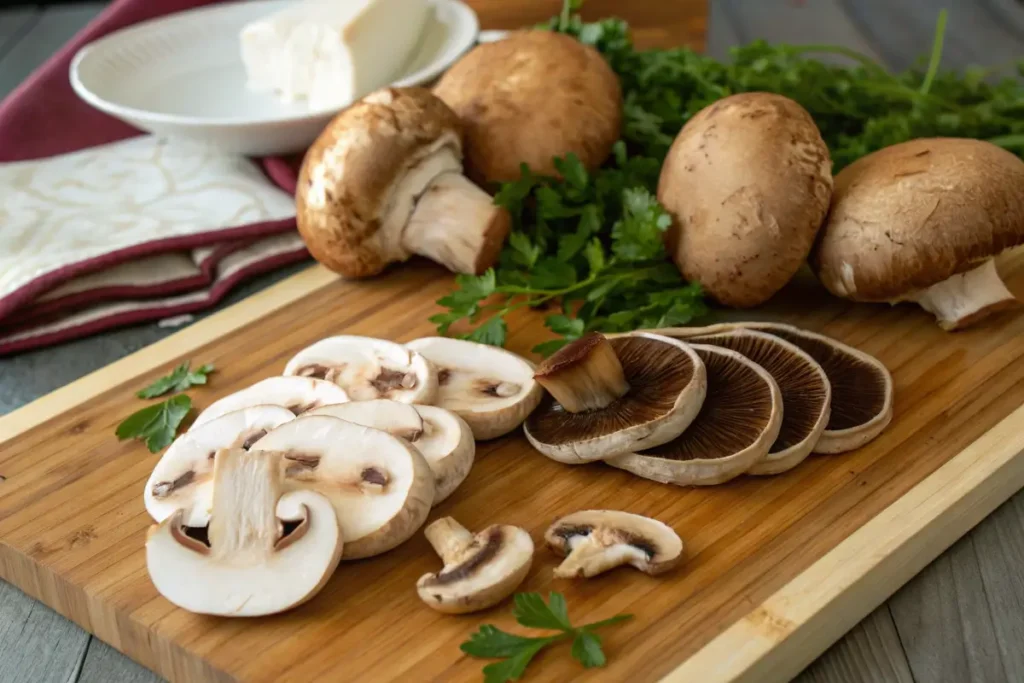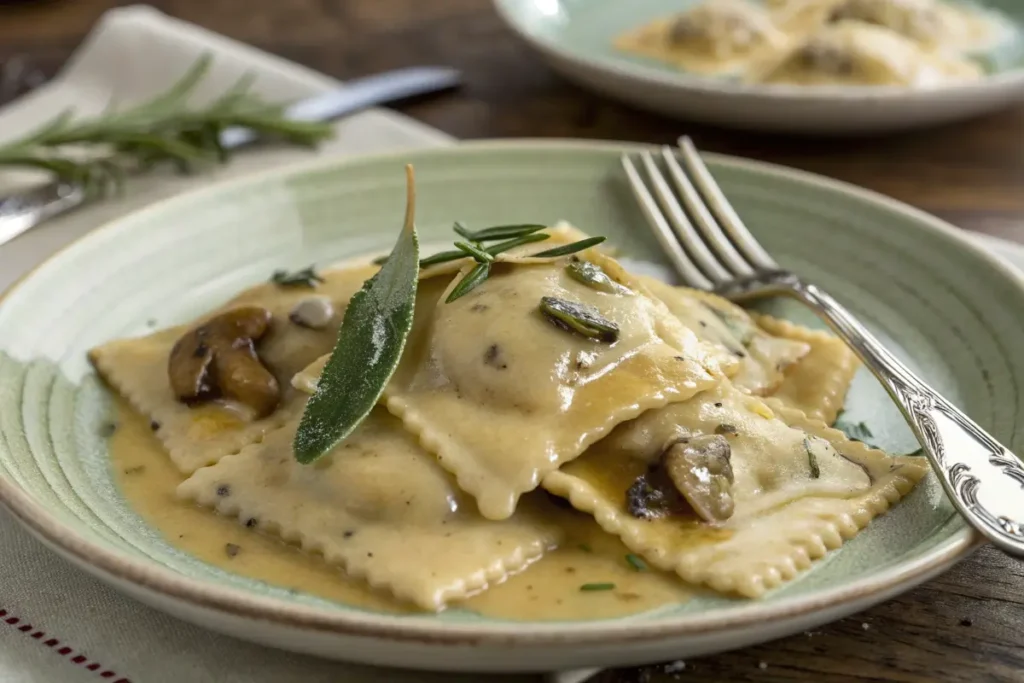Mushroom ravioli is a delectable dish that brings together the earthy flavor of mushrooms and the delicate texture of homemade pasta. Whether you’re a fan of vegetarian dishes or simply love the taste of mushrooms, this ravioli recipe is bound to impress. In this article, we’ll explore everything you need to know about making the perfect mushroom ravioli. From choosing the right ingredients to pairing it with mouth-watering sauces, we’ve got you covered. We’ll even touch on different variations and tips for storing and reheating your ravioli. Ready to dive in? Let’s get started!
Introduction to Mushroom Ravioli
What is Mushroom Ravioli?
Mushroom ravioli is a classic Italian dish that features a rich and savory filling made from mushrooms, wrapped in a delicate pasta dough. It’s the perfect comfort food, combining the softness of the ravioli shell with the umami flavor of the mushrooms. This dish is a staple in many Italian kitchens and has gained popularity worldwide, especially among vegetarians and mushroom lovers.
The filling typically includes finely chopped mushrooms sautéed with herbs and sometimes a touch of cheese. The dough can be made from scratch using flour, eggs, and water, or you can opt for store-bought sheets for convenience. Mushroom ravioli can be served with a variety of sauces such as creamy butter-based sauces, tomato sauce, or even a light broth for a more delicate touch.
Why Choose Mushroom Ravioli?
There are plenty of reasons to choose mushroom ravioli for your next meal. For one, mushrooms are a nutritional powerhouse, packed with vitamins, minerals, and antioxidants. They’re low in calories and fat, making mushroom ravioli a healthy yet satisfying option for lunch or dinner.
Additionally, mushroom ravioli is a fantastic choice for vegetarians, offering a rich, savory flavor without the need for meat. The earthy taste of mushrooms pairs perfectly with the soft, pillowy pasta, creating a well-rounded dish that’s both delicious and nutritious.
Whether you’re preparing it for a family dinner, a special occasion, or simply craving a comforting meal, mushroom ravioli delivers every time.
Ingredients for the Perfect Mushroom Ravioli
Fresh vs. Dried Mushrooms: What’s Best for Your Ravioli?
When it comes to making mushroom ravioli, the type of mushroom you choose can significantly impact the flavor and texture of the dish. Fresh mushrooms, such as cremini, shiitake, or portobello, are the most commonly used for ravioli. These mushrooms offer a rich, meaty texture that pairs perfectly with the soft, pillowy pasta. Fresh mushrooms also provide more moisture, which is crucial for creating a juicy filling. If you’re looking for a more delicate flavor, button mushrooms are a great option.
On the other hand, dried mushrooms, such as porcini or morel, pack a more concentrated flavor and a chewy texture. If you’re craving a more intense, earthy flavor, dried mushrooms are the way to go. Just remember to rehydrate them properly before using them as a filling in your mushroom ravioli. These mushrooms can also make your filling richer, but you may need to adjust the moisture content to avoid making the ravioli too wet.
For the best mushroom ravioli, consider using a combination of both fresh and dried mushrooms. This allows you to enjoy the delicate texture of fresh mushrooms while benefiting from the depth of flavor that dried mushrooms provide.

The Essential Ingredients for Homemade Mushroom Ravioli
To make the perfect mushroom ravioli, you’ll need the right combination of ingredients. Here’s a quick rundown of the must-have items for both the dough and the filling:
- Pasta Dough – Flour, eggs, water, and a pinch of salt are all you need to create the perfect ravioli dough. While you can purchase pre-made pasta sheets, homemade dough provides a softer texture that truly elevates your dish. If you’re going for a gluten-free version, you can substitute regular flour with a gluten-free mix.
- Mushrooms – As discussed earlier, fresh and dried mushrooms work best for ravioli. A blend of cremini, shiitake, or portobello mushrooms, complemented by a small handful of dried porcini, will give your ravioli a well-rounded, flavorful filling.
- Cheese – Adding cheese is optional, but it can really enrich the filling. Use ricotta, parmesan, or fontina for a creamy texture and savory taste.
- Herbs and Seasonings – A blend of garlic, thyme, oregano, and a little nutmeg will elevate the mushroom flavor. Don’t forget to season with salt and pepper to taste.
- Egg Yolk – To help bind the filling, an egg yolk is often added. It also helps give the ravioli a rich, golden color.
Step-by-Step Instructions for Making Mushroom Ravioli
How to Prepare the Mushroom Filling
Start by cleaning your mushrooms thoroughly. Remove the stems and slice the mushrooms into small pieces. To bring out the rich flavor, sauté the mushrooms in a pan with some olive oil or butter over medium heat. Add garlic, onions, and fresh herbs like thyme and oregano to intensify the flavor profile. Cook until the mushrooms release their moisture and it evaporates, leaving a concentrated, earthy mixture. You want the filling to be dry enough to prevent the ravioli from becoming soggy when boiled.
Once the mushrooms are cooked, remove them from heat and let them cool slightly. Then, transfer them to a food processor and pulse until finely chopped. If desired, add a spoonful of ricotta cheese or grated parmesan for extra richness. Season with salt, pepper, and a pinch of nutmeg for warmth.

Making the Pasta Dough from Scratch
Making fresh ravioli dough from scratch is simple and rewarding. Start by combining all-purpose flour and salt in a large bowl. Create a well in the center and crack two eggs into it. Gradually mix the eggs into the flour, adding a little water at a time until a dough forms. Knead the dough on a floured surface for about 8-10 minutes until smooth and elastic. Once done, cover the dough with a cloth and let it rest for at least 30 minutes.
Assembling the Ravioli
After the dough has rested, roll it out on a floured surface until it’s about 1/8 inch thick. Cut the dough into squares or circles using a knife or ravioli cutter. Place a teaspoon of the mushroom filling in the center of each square. Carefully fold the dough over to form a pocket, sealing the edges by pressing them together with a fork. Be sure to press the edges tightly to avoid any filling spilling out during cooking.
Cooking Your Mushroom Ravioli
Bring a large pot of salted water to a boil. Carefully drop the ravioli into the boiling water and cook for about 3-4 minutes or until they float to the top. Remove them with a slotted spoon and transfer them to a plate.
If you prefer your ravioli crispy, you can also sauté them in a pan with a bit of butter until golden brown on both sides. Serve your mushroom ravioli with your favorite sauce and enjoy!
Delicious Mushroom Ravioli Sauces
Best Sauces to Pair with Mushroom Ravioli
When it comes to serving your mushroom ravioli, the sauce you choose can make or break the dish. A creamy sauce can complement the earthy flavors of the mushrooms, while a lighter sauce may allow the ravioli to shine on its own. Let’s explore some of the best options:
- Brown Butter and Sage Sauce – One of the most classic pairings for mushroom ravioli, this sauce is rich and nutty with just the right amount of earthiness from the sage. To make it, melt butter in a pan and cook it until it turns golden brown. Add fresh sage leaves and sauté until crispy. The result is a savory sauce that enhances the flavor of the ravioli without overpowering it.
- Garlic and Parmesan Cream Sauce – If you’re craving a creamy texture, a garlic and parmesan cream sauce is a great choice. The rich and savory flavor of the garlic pairs perfectly with the mushroom ravioli, while the parmesan adds a tangy sharpness that cuts through the richness. To prepare, sauté garlic in butter, add heavy cream, and let it simmer until it thickens. Stir in grated parmesan and season with salt and pepper.
- Tomato and Basil Sauce – For those who prefer a lighter option, a fresh tomato and basil sauce is a wonderful choice. The acidity of the tomatoes balances the richness of the ravioli, while the basil adds a fragrant freshness. Simply sauté onions and garlic in olive oil, add crushed tomatoes, and let it simmer. Finish with fresh basil leaves, salt, and pepper.
- White Wine and Mushroom Sauce – Elevate your mushroom ravioli with a flavorful white wine sauce. Sauté mushrooms, garlic, and onions in butter, add white wine, and let it reduce until thickened. This sauce offers a subtle depth that perfectly complements the mushroom ravioli.

Creating a Homemade Cream Sauce for Mushroom Ravioli
A rich cream sauce is an ideal way to bring out the earthy flavors of the mushroom ravioli. Here’s how you can create a simple yet decadent cream sauce:
- Start by melting butter in a pan and sautéing chopped garlic until fragrant.
- Add heavy cream and bring it to a gentle simmer.
- Stir in grated parmesan or any other cheese of your choice for added richness.
- Season with salt, pepper, and a touch of nutmeg for warmth.
- Simmer until the sauce thickens to your liking and pour over your cooked ravioli.
This creamy sauce will elevate your mushroom ravioli to a new level of comfort food, making it the perfect choice for a cozy dinner.
Variations of Mushroom Ravioli You Can Try
Wild Mushroom Ravioli
If you’re looking to take your mushroom ravioli to the next level, consider using a mix of wild mushrooms in the filling. Chanterelle, morel, and shiitake mushrooms are excellent choices. They provide a more robust, earthy flavor than your regular button mushrooms. These wild varieties not only enhance the taste but also add a unique texture to your ravioli. For a truly gourmet experience, combine these mushrooms with a rich parmesan or ricotta filling for an unforgettable flavor.
Adding Cheese to Your Mushroom Ravioli
Cheese can elevate the flavor of your mushroom ravioli filling. The addition of ricotta cheese adds a creamy texture that complements the earthy mushrooms, while parmesan cheese brings a tangy sharpness. You can also try fontina cheese, which melts beautifully and adds a nutty flavor to your ravioli. For a vegan option, consider using cashew cheese or another plant-based alternative to maintain the creamy texture without the dairy.
Mushroom Ravioli with Different Fillings
While the traditional mushroom ravioli filling is always a hit, there are endless ways to customize it. You can mix in fresh spinach for added color and nutrition or add a touch of truffle oil to infuse a luxurious, aromatic flavor. If you prefer a richer, more decadent filling, try adding goat cheese or cream cheese to the mushroom mixture. These variations allow you to get creative with your ravioli while still keeping the core flavors intact.
If you’re feeling adventurous, consider adding other vegetables or herbs, like caramelized onions or a blend of fresh thyme, to make your ravioli truly unique. Whether you stick with the classic or venture into new territory, these variations will surely satisfy any palate.
These variations and sauce ideas will help you experiment with your mushroom ravioli, creating new combinations that suit your taste. For more delicious ideas, check out our Pastina Recipe for a comforting and versatile dish.
Mushroom Ravioli in Different Cuisines
Italian Mushroom Ravioli
When it comes to mushroom ravioli, Italy is undoubtedly the birthplace of this beloved dish. Traditional Italian mushroom ravioli is made with fresh pasta dough filled with earthy mushrooms, often complemented by a rich, buttery sauce. Italian chefs typically use mushrooms like cremini, shiitake, and porcini to create a savory filling that highlights the mushrooms’ natural flavors. The ravioli is then paired with a simple sauce, such as a brown butter and sage sauce, to let the mushrooms shine.
In Italy, mushroom ravioli is often served as a first course (antipasto) at family gatherings or special occasions. The rich flavors of the mushrooms, combined with the delicate texture of the ravioli, make it an unforgettable dish in Italian cuisine. Whether you’re dining in Tuscany or enjoying a homemade meal at home, mushroom ravioli remains a quintessential Italian dish that brings comfort and joy to the table.
Mushroom Ravioli in Other Cultures
While mushroom ravioli is most closely associated with Italian cuisine, other cultures also have their own variations of stuffed pasta or dumplings that feature mushrooms. In Eastern European countries, such as Poland, pierogi are a popular dish. These dumplings are often filled with a mixture of mushrooms, potatoes, and cheese, similar to mushroom ravioli but with a slightly different texture and preparation method.
In Chinese cuisine, mushroom dumplings are common, often served in a light broth or stir-fried with vegetables. These dumplings are typically made with a thinner wrapper than mushroom ravioli and are often enjoyed as part of dim sum meals. Though the preparation methods may differ, the concept of combining mushrooms with dough or pasta is a common thread that connects these diverse culinary traditions.
Storing and Reheating Mushroom Ravioli
How to Store Mushroom Ravioli
Once you’ve made your mushroom ravioli, you may want to store it for later use. If you’ve prepared fresh ravioli, you can freeze it to enjoy later. To store, place the ravioli on a baking sheet in a single layer and freeze until solid. Once frozen, transfer the ravioli to an airtight container or a resealable plastic bag. Frozen mushroom ravioli can last up to 3 months, allowing you to enjoy this homemade dish even when you don’t have time to cook from scratch.
If you plan to refrigerate your ravioli, store it in an airtight container for up to 2-3 days. However, freezing is the best option for long-term storage, as it helps preserve the flavor and texture.
Reheating Mushroom Ravioli Without Losing Flavor
Reheating mushroom ravioli requires a bit of care to maintain its delicate texture and rich flavor. For ravioli that’s been frozen, simply bring a large pot of salted water to a boil and cook the ravioli for about 4-5 minutes or until they float to the surface. If you’re reheating mushroom ravioli that’s been stored in the refrigerator, gently reheat it in a pan with some butter or sauce to prevent it from drying out.
Alternatively, you can sauté mushroom ravioli in a little butter or olive oil for a crispy exterior. This method gives the ravioli a delightful texture, making it even more delicious when reheated.
Nutritional Value of Mushroom Ravioli Nutritional Benefits of Mushroom Ravioli
- Mushroom ravioli* is a delicious and nutritious dish, offering a good balance of vitamins and minerals. Mushrooms, the star ingredient, are low in calories but packed with essential nutrients like fiber, antioxidants, and vitamins (such as B vitamins). They’re also an excellent source of protein for a plant-based meal.
A typical serving of mushroom ravioli contains a moderate amount of carbs from the pasta, while the mushroom filling provides a boost of fiber and nutrients. The addition of cheese, such as ricotta or Parmesan, enhances the dish’s calcium and protein content, making it a more balanced meal.
Overall, mushroom ravioli is a great option for those seeking a flavorful and healthy meal that is filling without being too heavy. It’s the perfect dish for a light lunch or a satisfying dinner.
How to Make Mushroom Ravioli Healthier
If you’re looking to make mushroom ravioli even healthier, there are several easy adjustments you can make. For a lighter version, use whole wheat or gluten-free pasta dough. You can also reduce the amount of cheese in the filling or opt for a lower-fat cheese like ricotta or a vegan substitute. Using less butter or oil in the sauce can help lower the fat content while still keeping the flavor intact.
Frequently Asked Questions
What type of mushrooms are best for ravioli?
The best mushrooms for mushroom ravioli are those that have a rich, savory flavor and a firm texture. Cremini, shiitake, portobello, and button mushrooms are excellent choices. If you want a more intense mushroom flavor, consider adding dried porcini mushrooms to the mix. Combining different types of mushrooms will give your ravioli a complex flavor profile.
Can I make mushroom ravioli without eggs?
Yes, it’s possible to make egg-free mushroom ravioli. For the dough, you can substitute eggs with a mixture of water and olive oil. There are also plenty of egg substitutes available, like flax seeds or chia seeds, which work well for binding the dough. This way, you can enjoy delicious ravioli without using eggs, making it suitable for vegan diets.
How do I prevent my ravioli from falling apart?
To prevent mushroom ravioli from falling apart during cooking, ensure that the pasta dough is rolled out evenly and not too thin. Seal the edges of the ravioli well by pressing them firmly with a fork to avoid any filling spilling out. Make sure the filling is not too wet—if it is, it can cause the ravioli to burst during cooking.
Can I make mushroom ravioli in advance?
Yes, you can make mushroom ravioli ahead of time. You can either freeze the ravioli or refrigerate it for a few hours before cooking. If you freeze them, place the ravioli in a single layer on a baking sheet to prevent sticking. Once frozen, transfer them to an airtight container or freezer bag. When you’re ready to cook, simply boil the ravioli from frozen for about 4-5 minutes.

